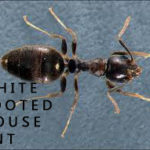
White Footed House Ant
Ant Control: Tackling the Annoying White-Footed House Ant
"Finding bits of ants falling from light fittings? It's more than just a nuisance..."
The Unexpected Housekeeping of Ants
What you might mistake for small black dust or debris around your home actually comes from white-footed ants practicing a unique form of 'housekeeping'. These ants consider deceased colony members as toxic and have specialized 'dumper ants' that remove these bodies from the nest. This process often results in piles of black dust and ant parts, particularly frustrating when it accumulates on beds, sofas, or kitchen countertops.
Understanding White-Footed Ants
Despite their name suggesting a lighter color, white-footed ants are primarily black with white hairs on their legs that may appear as 'white feet' under certain lighting. A mature colony can host between 8,000 to 3 million individuals, with up to 33 percent capable of reproduction.
Feeding Habits
These ants typically feed on honeydew and plant nectar but will invade homes in search of sweet liquids and water. Unique among many ant species, foraging white-footed ants do not share their food. Instead, they rely on sterile workers to produce 'trophic eggs' that serve as food for the larvae, non-foraging adults, and importantly, the queen.
Preferred Habitats
White-footed ants are adaptable to both urban and rural settings, often spreading via commercial activities like nursery stock or shipping containers. They favor nesting sites that provide moisture, food, and protection from predators and the elements. Common nesting sites include moist areas under bark or rocks, decaying wood, and old termite galleries. Inside homes, they can be found in wall voids, attics, under roof shingles, and near moisture sources in kitchens and bathrooms.
Threats and Challenges
These ants pose no stinging threat and do not cause structural damage but can be a significant nuisance. Originating from Queensland and first detected in New Zealand at the Port of Nelson in 1962, they prefer warm, dry environments inside man-made structures, making their nests difficult to access and treat.
Challenges with Conventional Baiting
Traditional baiting techniques are often ineffective against white-footed ants because the queen is fed directly by specialized workers, preventing DIY baits from reaching her. As a result, these baits typically eliminate only older ants, inadvertently rejuvenating the colony with younger, more active members.
How ACES Pest Control Can Help
At ACES, we understand the unique biology of the white-footed house ant and tailor our approach accordingly. We utilize advanced 'transfer' products from the USA and Germany to penetrate and destroy the colony effectively, ensuring the cessation of ant dumping and other nuisances.
Contact ACES | Ants for Effective Relief
Tired of unwanted ant guests? Contact ACES | Ants today, and let us deliver a great result for your ant problems!
